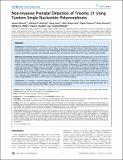Non-Invasive Prenatal Detection of Trisomy 21 Using Tandem Single Nucleotide Polymorphisms
Author(s)
Ghanta, Sujana; Mitchell, Michael E.; Ames, Mary; Hidestrand, Mats; Simpson, Pippa; Goetsch, Mary; Thilly, William G.; Struble, Craig A.; Tomita-Mitchell, Aoy; ... Show more Show less
DownloadGhanta-2010-Non-Invasive Prenata.pdf (2.017Mb)
PUBLISHER_CC
Publisher with Creative Commons License
Creative Commons Attribution
Terms of use
Metadata
Show full item recordAbstract
Background
Screening tests for Trisomy 21 (T21), also known as Down syndrome, are routinely performed for the majority of pregnant women. However, current tests rely on either evaluating non-specific markers, which lead to false negative and false positive results, or on invasive tests, which while highly accurate, are expensive and carry a risk of fetal loss. We outline a novel, rapid, highly sensitive, and targeted approach to non-invasively detect fetal T21 using maternal plasma DNA.
Methods and Findings
Highly heterozygous tandem Single Nucleotide Polymorphism (SNP) sequences on chromosome 21 were analyzed using High-Fidelity PCR and Cycling Temperature Capillary Electrophoresis (CTCE). This approach was used to blindly analyze plasma DNA obtained from peripheral blood from 40 high risk pregnant women, in adherence to a Medical College of Wisconsin Institutional Review Board approved protocol. Tandem SNP sequences were informative when the mother was heterozygous and a third paternal haplotype was present, permitting a quantitative comparison between the maternally inherited haplotype and the paternally inherited haplotype to infer fetal chromosomal dosage by calculating a Haplotype Ratio (HR). 27 subjects were assessable; 13 subjects were not informative due to either low DNA yield or were not informative at the tandem SNP sequences examined. All results were confirmed by a procedure (amniocentesis/CVS) or at postnatal follow-up. Twenty subjects were identified as carrying a disomy 21 fetus (with two copies of chromosome 21) and seven subjects were identified as carrying a T21 fetus. The sensitivity and the specificity of the assay was 100% when HR values lying between 3/5 and 5/3 were used as a threshold for normal subjects.
Conclusions
In summary, a targeted approach, based on calculation of Haplotype Ratios from tandem SNP sequences combined with a sensitive and quantitative DNA measurement technology can be used to accurately detect fetal T21 in maternal plasma when sufficient fetal DNA is present in maternal plasma.
Date issued
2010-10Department
Massachusetts Institute of Technology. Department of Biological EngineeringJournal
PLoS ONE
Publisher
Public Library of Science
Citation
Ghanta, Sujana et al. “Non-Invasive Prenatal Detection of Trisomy 21 Using Tandem Single Nucleotide Polymorphisms.” PLoS ONE 5.10 (2010): e13184.
Version: Final published version
ISSN
1932-6203